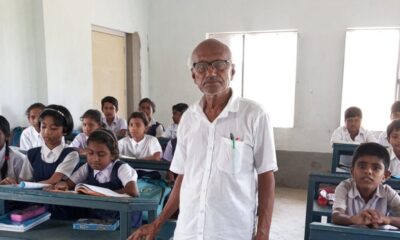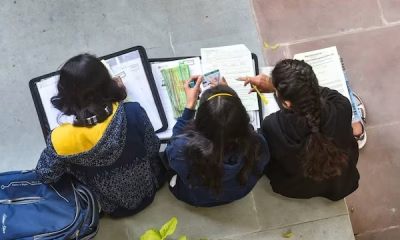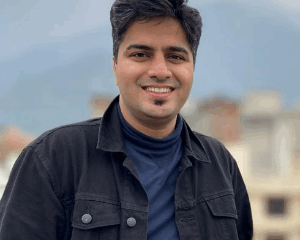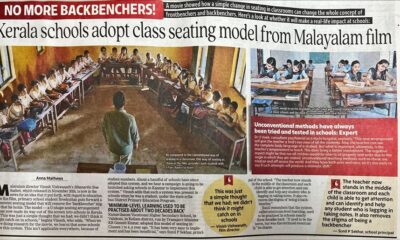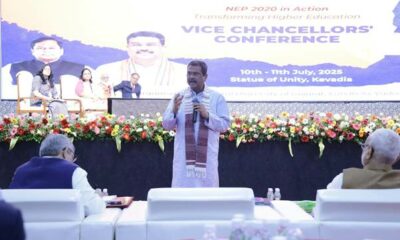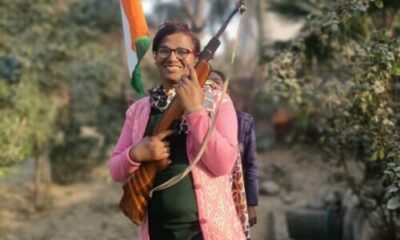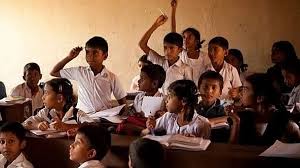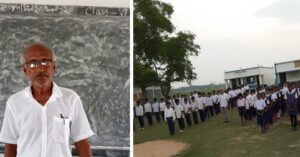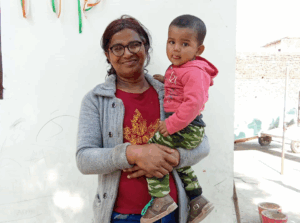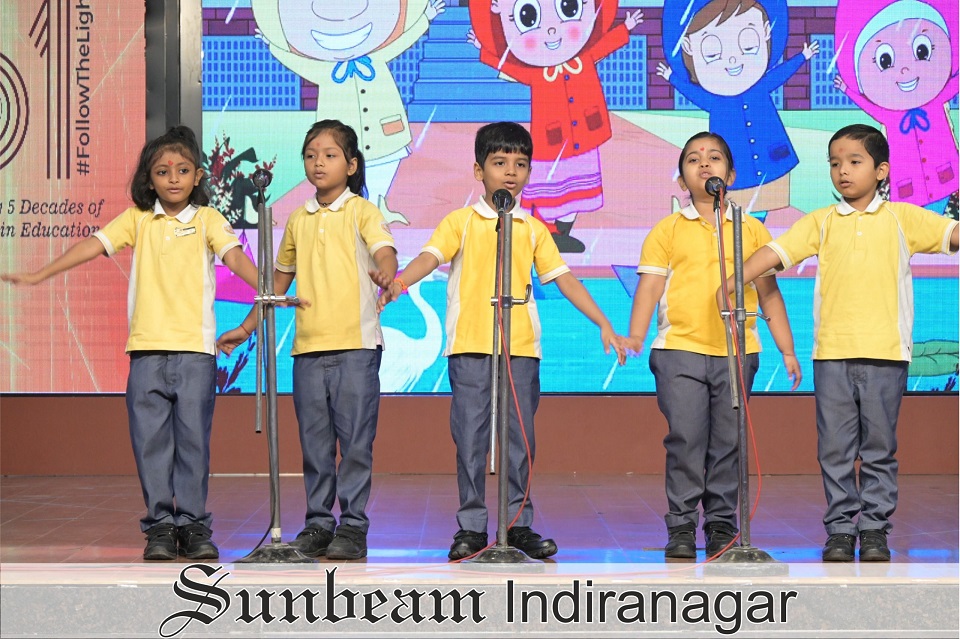Inspiration
Classic inspirational poems guaranteed to enliven the soul
Here is a selection of truly inspirational poems, which have stood the test of time with their wealth of beauty and meaning…A lesson in life that we can learn from, and help teach those in need along the way.

Poetry is not just rhymes strung together, it is a symphony of words that have deep meaning, endowed with the power to inspire minds and change lives. Poems are for everyone – man, woman, child, student, teacher, as long as you can find resonance with them. It is said that the pen is mightier than the sword, but the words written are the mightiest of them all. Here is a selection of truly inspirational poems, which have stood the test of time with their wealth of beauty and meaning…A lesson in life that we can learn from, and help teach those in need along the way.
If
By Rudyard Kipling
If you can keep your head when all about you Are losing theirs and blaming it on you; If you can trust yourself when all men doubt you, But make allowance for their doubting too; If you can wait and not be tired by waiting, Or, being lied about, don’t deal in lies, Or, being hated, don’t give way to hating, And yet don’t look too good, nor talk too wise; If you can dream—and not make dreams your master; If you can think—and not make thoughts your aim; If you can meet with triumph and disaster And treat those two impostors just the same; If you can bear to hear the truth you’ve spoken Twisted by knaves to make a trap for fools, Or watch the things you gave your life to broken, And stoop and build ‘em up with wornout tools; If you can make one heap of all your winnings And risk it on one turn of pitch-and-toss, And lose, and start again at your beginnings And never breathe a word about your loss; If you can force your heart and nerve and sinew To serve your turn long after they are gone, And so hold on when there is nothing in you Except the Will which says to them: “Hold on”; If you can talk with crowds and keep your virtue, Or walk with kings—nor lose the common touch; If neither foes nor loving friends can hurt you; If all men count with you, but none too much; If you can fill the unforgiving minute With sixty seconds’ worth of distance run— Yours is the Earth and everything that’s in it, And—which is more—you’ll be a Man, my son!
Message:
The poem talks about how man must be humble, patient, rational, truthful, dependable, and persevering. Man must have faith in himself when all others doubt him. When what he says is misconstrued, he must be able to stand strong and deal with it. Kipling says that the true measure of a man is his humility and stoicism.
Still I Rise
By Maya Angelou
You may write me down in history With your bitter, twisted lies, You may trod me in the very dirt But still, like dust, I’ll rise. Does my sassiness upset you? Why are you beset with gloom? ‘Cause I walk like I’ve got oil wells Pumping in my living room. Just like moons and like suns, With the certainty of tides, Just like hopes springing high, Still I’ll rise. Did you want to see me broken? Bowed head and lowered eyes? Shoulders falling down like teardrops, Weakened by my soulful cries? Does my haughtiness offend you? Don’t you take it awful hard ‘Cause I laugh like I’ve got gold mines Diggin’ in my own backyard. You may shoot me with your words, You may cut me with your eyes, You may kill me with your hatefulness, But still, like air, I’ll rise. Does my sexiness upset you? Does it come as a surprise That I dance like I’ve got diamonds At the meeting of my thighs? Out of the huts of history’s shame I rise Up from a past that’s rooted in pain I rise I’m a black ocean, leaping and wide, Welling and swelling I bear in the tide. Leaving behind nights of terror and fear I rise Into a daybreak that’s wondrously clear I rise Bringing the gifts that my ancestors gave, I am the dream and the hope of the slave. I rise I rise I rise.
Message:
A powerful and empowering poem about struggles faced and how to overcome them. It sends out a message to all those who face hardship, telling them that, no matter what the circumstances, always have hope and cling on to it.
Heart of A Teacher
By Paula J. Fox
The child arrives like a mystery box…
with puzzle pieces inside
some of the pieces are broken or missing…
and others just seem to hide
with puzzle pieces inside
some of the pieces are broken or missing…
and others just seem to hide
But the HEART of a teacher can sort them out…
and help the child to see
the potential for greatness he has within…
a picture of what he can be
and help the child to see
the potential for greatness he has within…
a picture of what he can be
Her goal isn’t just to teach knowledge…
by filling the box with more parts
it’s putting the pieces together…
to create a work of art.
by filling the box with more parts
it’s putting the pieces together…
to create a work of art.
The process is painfully slow at times…
some need more help than others
each child is a work in progress…
with assorted shapes and colors
some need more help than others
each child is a work in progress…
with assorted shapes and colors
First she creates a classroom…
where the child can feel safe in school
where he never feels threatened or afraid to try…
and kindness is always the rule
where the child can feel safe in school
where he never feels threatened or afraid to try…
and kindness is always the rule
She knows that a child can achieve
much more when he feels secure inside
when he’s valued and loved…and believes in himself …
and he has a sense of pride
much more when he feels secure inside
when he’s valued and loved…and believes in himself …
and he has a sense of pride
She models and teaches good character…
and respect for one another
how to focus on strengths…not weaknesses
and how to encourage each other
and respect for one another
how to focus on strengths…not weaknesses
and how to encourage each other
She gives the child the freedom he needs…
to make choices on his own
so he learns to become more responsible…
and is able to stand alone
to make choices on his own
so he learns to become more responsible…
and is able to stand alone
He’s taught to be strong and think for himself…
as his soul and spirit heal
and the puzzle that’s taking shape inside…
has a much more positive feel
as his soul and spirit heal
and the puzzle that’s taking shape inside…
has a much more positive feel
The child discovers the joy that comes…
from learning something new…
and his vision grows as he begins
to see all the things he can do
from learning something new…
and his vision grows as he begins
to see all the things he can do
A picture is formed as more pieces fit…
an image of the child within
with greater strength and confidence…
and a belief that he can win!
an image of the child within
with greater strength and confidence…
and a belief that he can win!
All because a hero was there…
in the HEART of a teacher who cared
enabling the child to become much more…
than he ever imagined…or dared
in the HEART of a teacher who cared
enabling the child to become much more…
than he ever imagined…or dared
A teacher with a HEART for her children…
knows what teaching is all about
she may not have all the answers…
but on this…she has no doubt
knows what teaching is all about
she may not have all the answers…
but on this…she has no doubt
When asked which subjects she loved to teach,
she answered this way and smiled…
“It’s not the subjects that matter…
she answered this way and smiled…
“It’s not the subjects that matter…
It’s all about teaching the CHILD.”
Message:
A beautiful poem that talks about the very core of what a teacher really is; how through love and care she helps her students shine. By being patient, as each child is different where some of them might be slow and others need more help, she builds their confidence. She keeps them safe, focuses on their strengths and not their weaknesses, encourages them and gives them their space to become strong and responsible human beings.
Invictus
By William Ernest Henley
Out of the night that covers me,
Black as the pit from pole to pole,
I thank whatever gods may be
For my unconquerable soul.
It matters not how strait the gate,
How charged with punishments the scroll,
I am the master of my fate,
I am the captain of my soul.
Message:
The poet explains that life has its ups and downs and that one must be strong-willed and stay unconquered. Even though we feel that there is no hope and face many hurdles, we must not give up; we must stay strong, keep our chin up and do whatever it takes to overcome it. We must keep faith so that nothing can shatter us and we can face anything that is put in front of us. The poet says that the world is a dark place but he thanks God as our souls cannot be ruled by anyone and is independent, just like our thoughts.
A Character
By William Wordsworth
I marvel how Nature could ever find space
For so many strange contrasts in one human face:
There’s thought and no thought, and there’s paleness and bloom
And bustle and sluggishness, pleasure and gloom.
There’s weakness, and strength both redundant and vain;
Such strength as, if ever affliction and pain
Could pierce through a temper that’s soft to disease,
Would be rational peace–a philosopher’s ease.
Message:
The poet describes society and the character of the human race. He talks about the contrasts in human faces, their different moods and personalities. The poem relates to the yin and yang, the good and the bad and how they must all co-exist on this earth. He says that humans are both flawed and beautiful and sometimes flaws add to the beauty. He writes about strengths and weaknesses, how they are opposites, how sometimes too much of strength can destroy things and sometimes there is greater strength in restraint. Life must have a balance of everything. We must not only look for or experience the good; we must go through hardship which helps us learn and that is the beauty of life.
Mending Wall
By Robert Frost
Something there is that doesn’t love a wall,
That sends the frozen-ground-swell under it
And spills the upper boulders in the sun,
And makes gaps even two can pass abreast.
Let my neighbour know beyond the hill;
And on a day we meet to walk the line
And set the wall between us once again.
We keep the wall between us as we go.
Message:
There are two views to this poem; that of the narrator and his neighbour. This poem is a representation of what today’s society is all about. It reflects the fact that man-made barriers (the wall) exist between men, groups, and nations based on discrimination of race, caste, creed, gender and religion. The neighbour’s opinion is that it is good to have these walls as it sets limits and rights of each individual. The wall also represents building goodwill and trust between people.
This article was originally published in the Anniversary (August 2017) issue of ScooNews magazine. Subscribe to ScooNews Magazine today to have more such stories delivered to your desk every month.
Education
The Man Who Called His Students Gods: Dwijendranath Ghosh
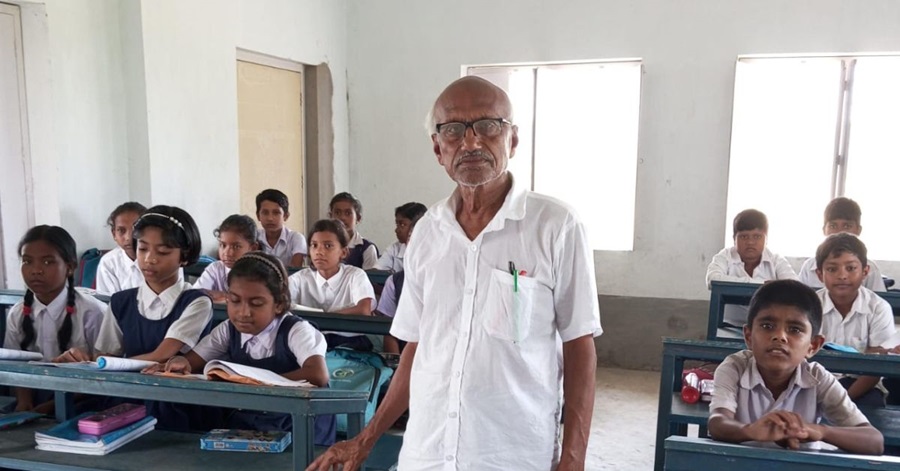
Dwijendranath Ghosh calls himself ordinary.
But how many “ordinary” people spend their retirement building a school from scratch — with no funding, no government salary, and no promise of support? How many choose to teach every day, without compensation, well into their 70s? And how many refer to their students — many from the most marginalised sections of rural Bengal — as gods?
At 78, Ghosh is the heart and soul of Basantapur Junior High School in West Bengal’s Hooghly district. He opens the gate each morning. He teaches children for free. He never left his village — but his impact now reaches far beyond it.
From Barefoot Dreams to Blackboards
Ghosh’s journey is rooted in personal struggle. Growing up in deep poverty, he had no books, no uniforms, and no certainty. His childhood was spent walking barefoot to school, borrowing textbooks, and studying by the glow of kerosene lamps. And yet, he rose. A master’s degree from Burdwan University followed in 1973.
“The pain of those days still haunts me,” he says. “But it also shaped me.”
That pain turned into purpose. Soon after graduating, he and a few friends began running an informal high school in their village—unrecognised, unpaid, but unstoppable. For nine years, they taught with nothing but commitment. When the government finally recognised the school in 1982, Ghosh had already left to take a government job elsewhere, forced by financial needs.
The Second School
He retired in 2008. But instead of resting, he returned to his village and found that little had changed. Girls were still dropping out after primary school. Child marriage was common. A generation was fading into invisibility. So he began again. With no funding, no building, and no staff, he worked for five years to create Basantapur Junior High School.
In 2014, the school was officially recognised. But the journey was never about the paperwork — it was about presence. Every morning, Ghosh arrives before the first bell. He teaches, supports, and uplifts — without compensation. Because for him, teaching is service.
A Volunteer Army — Running on Faith
He’s not alone. A team of young, educated, but unemployed volunteer teachers stands beside him. They could have chosen easier paths, but chose this one out of belief, not benefit. They are unpaid. At times, local donors offer small stipends, but it’s inconsistent. Most are struggling, yet they return every day. “They have given the most valuable years of their lives,” Ghosh says.
The school receives only ₹25,000 a year as a government grant. For three years, even that was inaccessible. What kept it alive? Former students, now grown, are donating what they can. The community is pitching in. Alumni returning to teach. When a government teacher recently disrespected the volunteers, the team almost walked out. But students and parents wouldn’t let them. Ghosh stepped in to calm tensions.
“We can’t let one bad moment undo decades of good,” he told them.

A Temple Against Child Marriage
One of the school’s biggest challenges is child marriage. In villages like Basantapur, girls are often married by 14—seen as burdens, not futures. By offering local access to education, the school has become a shield. Many girls have completed higher education here. But the battle continues. “This trend,” Ghosh says, “is like an infection. It keeps coming back.”
At Basantapur Junior High School, learning is about more than grades. Students perform in cultural shows, play football and cricket, and take part in morning assemblies. They learn to speak, to lead, to dream. There’s no structured life skills module—because the school itself is the life lesson. Students know they are seen, heard, and cared for. Teachers know their work matters. And visitors walk away knowing this is not just a school—it’s a movement.
His empathy, his daily discipline, and his belief in every child form the blueprint that his students follow. And his impact lives in their dreams.
The Final Lesson
What does his family think?
“They worry about my health,” he laughs. “Not about the money.”
His pension is enough for his needs. What he seeks is not comfort — but recognition for his team. “These teachers have earned the right to be made permanent. A hundred times over,” he says.
When asked what keeps him going, he simply says:
“So long as I am in the school, I am alive.”
In an education system obsessed with metrics, Ghosh offers something rare: meaning.
He didn’t build a career.
He built a sanctuary.
He didn’t earn a salary.
He earned generations of gratitude.
And in every child who enters Basantapur Junior High, the final lesson is quietly imprinted:
Service is not sacrifice. It’s grace.
Education
A School Without Walls: The Pehchaan Story, Led by Akash Tandon
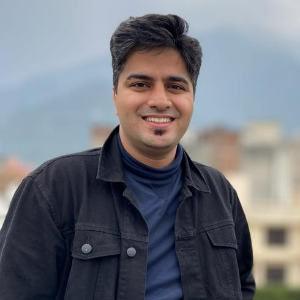
Sometimes the biggest change begins with the smallest act — a few mats on the ground, five curious children, and a group of young volunteers refusing to look away.
In the heart of Delhi, just steps away from the WHO headquarters and the grandeur of Lutyens’ Delhi, an open drain separates two vastly different worlds. On one side: embassies, privilege, policy. On the other: a slum of over 10,000 people, where childhood is often lost to labour, illness, and invisibility.
It’s here that Pehchaan — The Street School — took root.
“We knew we couldn’t change the world. But we could change someone’s world.”
For co-founder Akash Tandon, Pehchaan wasn’t part of a five-year plan. It was a response. A moment of reckoning, watching children play in a toxic drain, unaware of the danger. “This isn’t water,” they told the kids. “It’s poison.” The kids laughed.
That laugh stayed with them.

So Akash and his friends returned. Not with speeches or slogans — but with notebooks, mats, and the stubborn belief that every child, no matter their address, deserves to learn.
What started as a weekend effort with five students has now grown into a network of 10 centres, reaching over 1,600 children. And yet, Pehchaan remains fiercely grassroots — no paid staff, no office, no formal backing. Just a living, breathing movement powered entirely by volunteers.
Education That Heals
Pehchaan doesn’t just teach. It listens. It adapts. It believes that the first step to learning is dignity — and that means personalised mentorship, trust, and a curriculum that sees the child beyond the textbook.
Children are grouped into three learning tracks: those already in school who need support, dropouts looking to rejoin, and first-time learners who’ve never stepped inside a classroom. The model is lean but layered — with low student-volunteer ratios, personalised goals, and modules that blend academics with life skills.
There’s dance, storytelling, debate, and painting. There’s coding and digital literacy. And there’s space to be seen.
“My school encouraged me to sing, speak, perform,” says Preeti Adhikari, a longtime Pehchaan volunteer. “These children deserve that too. Because it’s not just about marks — it’s about confidence.”
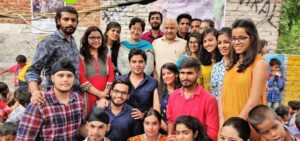
From Drain to Degree
One story stays close to Akash’s heart.
A boy joined Pehchaan in Class 3. He faced pressure to drop out and start working. But he stayed. Pehchaan gave him academic support, counselling, and community. He completed Class 12 with 86%. Then cracked the Delhi University entrance exam.
But the resistance didn’t stop. “What will you earn from books?” neighbours asked. Still, Pehchaan raised the funds, got him into college — and today, that boy teaches at the same centre where he once sat as a student.
“He’s the proof,” Akash says. “That this works. That this matters.”
A System That Runs Without a System
Despite being volunteer-run, Pehchaan operates with the discipline of a corporate team. Every 10 teaching assistants report to a centre head. Weekly reports are filed. Interns handle HR, design, digital media, and curriculum — all without salaries.
In 2024 alone, 8,000+ interns from 75+ colleges joined hands with Pehchaan. Many now lead verticals, train others, or launch their own community learning spaces.
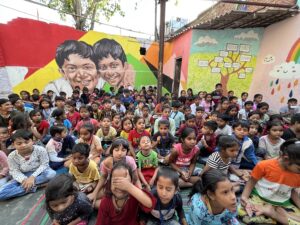
“Earlier I taught five kids,” one intern said. “Now I’m hiring 30 volunteers who each teach five. That’s impact at scale.”
The community, too, is beginning to notice. Blanket drives, nutrition partnerships, and the newly launched Digital Literacy Lab — built with scrap funding and donated laptops — have brought a sense of permanence to the pop-up classrooms.
But the hardest barrier? Still parents.
“You show up for 10 years — then they believe you.”
Convincing slum families to send their children — especially girls — to informal schools was a long battle. Many children still get married by 14. Others are pushed into work.
But when the same group of volunteers keeps returning, year after year, in sun, rain, or smog — trust begins to grow. “We’ve moved beyond convincing now,” Akash reflects. “We’re building the next layer. It’s about dignity.”
Girls who once never stepped outside now give public speeches. Boys once caught in addiction now mentor others.
Akash is clear about the goal: “We don’t want to go pan-India. We want 50 other Pehchaans to emerge. That’s how you scale — by letting go.”
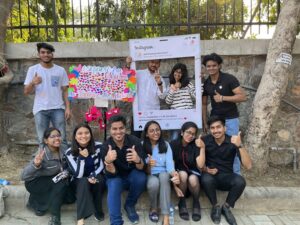
Read the full story in our latest issue, Teacher Warriors 2025.
Education
The Woman Who Refused to Disappear – Aditi Sharma’s Quiet Fight for Education
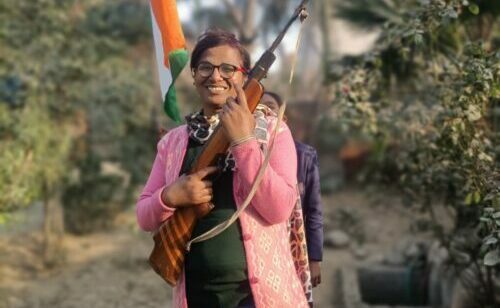
In a quiet corner of Karnal, Haryana, Aditi Sharma runs a small school for underprivileged children. She is the founder, principal, and often, the only teacher. As a transgender woman in North India, her journey has been marked by resistance and isolation — but also by unwavering commitment. Her school may lack formal recognition or resources, but it stands as a space of learning, inclusion, and quiet resilience.
Aditi is not just the founder and principal of Haryana Public School. She is also a transgender woman who dared to imagine a different kind of North India — one where prejudice makes way for possibility, and education belongs to everyone.
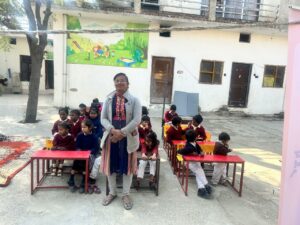
But dreams, she learned early on, come at a cost.
Born and raised in Delhi, Aditi was no stranger to the stereotypes that shadow the transgender community.
“Even educated people carry the assumption that all trans people beg or perform ceremonial rituals. That’s the stereotype I grew up seeing around me,” she says.
It disturbed her and lit the fuse of quiet rebellion.
Leaving Delhi behind, she moved to Karnal with one goal: to build a school not just for visibility, but for children who had nowhere else to go. Her father, unaware she had come out, gave her a 1,200-square-yard plot to build on. “At the time, I hadn’t fully come out. Had they known I was transgender, they wouldn’t have named it to me.”
What she built wasn’t just a school — it was a statement.
In the beginning, there were no teachers, no steady funds, and no blueprint. “I doubted whether I could run a school at all. I had no confidence. But slowly, a few children started coming in. Then a few more. At one point, we had 60–70 students.”
That number dropped, not due to a lack of dedication, but constant harassment. Neighbours let their dogs loose outside. Parents were warned, “Why send your child there? This isn’t a real school.” Some believed her identity disqualified her from leadership, from teaching, from existing with dignity.
She persisted anyway.
Aditi never set out to run a school for underprivileged children. It wasn’t a strategic choice or a targeted mission. It was simply what remained when everyone else walked away. Families who could afford higher fees refused to send their children to a school run by a transgender woman. Teachers quit under social pressure. So she opened her doors to those who had nowhere else to go — children whose families could pay ₹100 a month, sometimes just ₹50, and often nothing at all. “If they don’t learn here, they won’t learn anywhere,” she says. And so she teaches — not because it’s easy, but because no one else will.
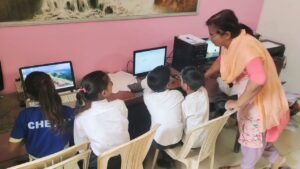
Her day begins at 4 AM — cleaning, prepping, sourcing supplies. By 8 AM, she’s teaching English, guiding students through computing tasks, or painting with them on borrowed desktops. She buys second-hand books herself. There are no permanent staff members. Most teachers leave within weeks. “They say, ‘My family doesn’t want me working here.’ The social pressure is immense.”
Once, a neighbour handed her a one-day-old baby and walked away. Aditi cared for her. When the child fell ill, she spent 12 days at the hospital with her — and the other children. Alone. “They don’t speak to me anymore,” she says of her family. “I’ve learned to let go. If someone doesn’t want to stay in touch, that’s okay. You still have to be happy.”
Haryana Public School is still not recognised by the state government. Despite its large plot, authorities claim she doesn’t meet the criteria. “Other schools on smaller land get recognised,” she says. “But because I’m transgender, they say no.” Her case is currently being reviewed by the Human Rights Commission. Justice Lalit Batra, in a hearing, reportedly said:
“If she doesn’t meet your current rule, change the rule.”
Meanwhile, the children continue to learn — with donated books, basic tools, and the irrepressible will of one woman. Aditi has even built two giant model airplanes — one stretching 20 feet — from scrap and wood. “They don’t fly, but they spark curiosity. Ten children can sit inside. It makes them dream.”
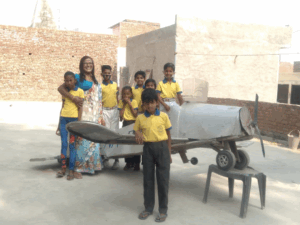
And dreams are something she insists on, even when the world offers no applause. “One child had developmental issues. No school would take him. People told me I was wasting my time. But he deserved a chance.”
Sometimes, appreciation is scarce. Respect even more so. “When parents don’t respect you, neither do their children,” she admits. “When your own life is a constant struggle, it becomes hard to build emotional bonds.”
But she still shows up every day. Reporters ask why so many people visit her school. “Because we’re doing something that shakes the norms,” she tells the children. “This school is special.”
And they believe her. Because children don’t discriminate. Adults do.
Her message to the transgender community is clear:
“Don’t wait for society to accept you. Build your own path. Even if you’re the only one walking it.”
Aditi Sharma may be the only openly transgender woman in North India running a school. But she’s not asking for sympathy. Just space. Just dignity. Just the right to show up — and not disappear.
“Even if only one child comes,” she says,
“I’ll keep the doors open.”
Read the full story in our latest Teacher Warriors issue: https://scoonews.com/magazines/scoonews-june-july-2025-digital-edition/
Education
A Vision Beyond Sight – How Aarti Takawane is Rewriting Futures for Blind Girls
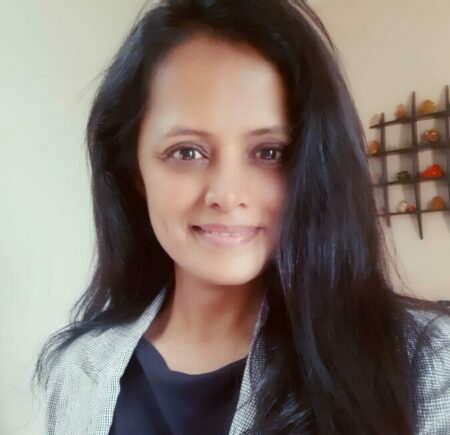
Sometimes, the most extraordinary journeys begin with an ordinary restlessness — that nagging sense that comfort isn’t enough. For Aarti Takawane, that quiet realisation led her to walk away from a secure corporate job, and towards a mission she never imagined for herself.
Aarti’s early career looked like everything most people might aspire to: a steady job, good salary, and the kind of stability that makes parents proud. But deep down, she felt a pull that numbers and meetings just couldn’t satisfy. With a background in psychology and a genuine desire to help others, she always knew her purpose lay in people, not just profit.
That spark turned into a flame when she met Mrs Meera Badve, founder of Niwant, an organisation supporting blind students in higher education. A casual encounter at a social event became a life-changing conversation. Aarti took a leap of faith and began volunteering at Niwant — and for the first time, she felt what it was like to make an impact where it truly mattered.
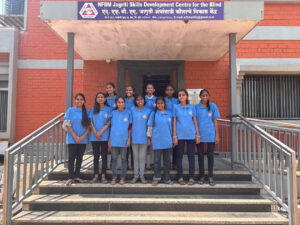
Her path eventually led her to the National Federation of the Blind’s Jagriti School for Blind Girls in Pune — a place that today houses 110 blind girls, 99% of whom come from rural areas. Here, the girls don’t just study; they live, learn, and grow together in an environment that believes in what they can do, rather than what they can’t.
When Aarti joined Jagriti, she began as a psychologist, focusing on the social and emotional development of the girls. But the more she listened to their dreams and struggles, the more she saw the barriers waiting for them after school. “When you give them the right tools, you’re not just giving them a skill — you’re giving them back their choice,” she reflects.
Visually-challenged girls face a stark reality once they step out into the world. Apart from limited government quota jobs in banks or insurance, there were few opportunities that truly matched their abilities. So, Aarti decided to do something about it.
“True empowerment means they can live with dignity, not just survive.”
She founded the Skill Development Centre inside Jagriti School — a space where blind girls could learn practical, job-ready skills that tap into their real strengths. Many of the students have remarkable listening and verbal abilities. So the Centre offers courses that play to these strengths: voice modulation, foreign languages, recruitment training, and more. There are also classes in computer literacy, digital accessibility testing, and even coaching for competitive exams.

But the real magic lies in how the Centre stays rooted in reality. The team works closely with organisations like Vision-Aid India and inclusive employers to keep training aligned with what the industry actually wants. Each student’s strengths and interests are mapped out with care, so the training feels personal and purposeful.
Equally important is what happens beyond the classroom. Many girls arrive at Jagriti shy, anxious, or unsure of themselves. They may have never used a screen reader, travelled alone, or spoken up in public. So the Centre pairs technical skills with confidence-building: mobility training, decision-making workshops, life skills, and emotional support.
“They didn’t need sympathy — they needed direction, support and opportunity,”
Funding is always a tightrope act — a mix of donations, CSR partnerships, and the occasional government grant keeps the Centre alive. It covers trainer salaries, hostel facilities, assistive technology, and learning materials. The school is committed to full transparency with its supporters, many of whom return year after year because they can see exactly where their help is going.

Aarti knows that none of this would be possible without the right people leading the way. Every teacher or trainer goes through orientation in assistive technology and inclusive education. Sensitisation workshops and regular feedback from students make sure the environment stays supportive and respectful.
As the world changes, so do Aarti’s dreams for the Centre. She hopes to introduce advanced digital modules, remote work training, and a stronger network of inclusive employers. But what excites her most is the chance to rewrite how society sees disability, not as a barrier, but as a different kind of potential waiting to be unlocked.
For the 110 girls who call Jagriti School home, Aarti Takawane is more than just a teacher. She’s proof that sometimes, the best things really do happen by accident — and that true vision is not about what we see, but what we choose to do about what we can’t.
Read the full story in our issue of Teacher Warriors 2025 at https://scoonews.com/magazines/scoonews-june-july-2025-digital-edition/
Education
“We Sleep on Walls Here”: Shubhanshu Shukla Talks to Indian Students from Space

Astronaut Shubhanshu Shukla, currently stationed aboard the International Space Station (ISS), answered questions from schoolchildren during a live interaction hosted under ISRO’s Vidyarthi Samvad Program.
The session, designed to bring students closer to the realities of space science, turned into a heartwarming and humorous conversation about food, sleep, and the sheer wonder of viewing Earth from space.
When asked how astronauts sleep in zero gravity, Shukla smiled and explained: “There is no floor or ceiling in space. Some of us sleep on the wall, some on the ceiling. We have to tie ourselves down so we don’t float away while sleeping.”
The conversation became sweeter when Shukla revealed that he brought familiar Indian flavours with him into orbit. “I have carried gajar ka halwa, moong dal halwa, and mango juice with me from India,” he said, to the delight of the young audience. He clarified that the halwa was specially medicated for space missions, not made at home — a detail that sparked laughter and curiosity alike.
The astronaut also spoke about daily life aboard the ISS, including how exercise is essential to counter microgravity. “We ride bicycles here, but there are no seats. We strap ourselves in with belts,” he told the children, who were both fascinated and amused by the image.
For Shukla, however, the highlight of being in space remains the view of Earth. “That blue sphere, that light mist… seeing Earth from here is the most beautiful experience. It’s hard to describe in words.”
Addressing mental well-being, he shared how astronauts stay connected with their families. “Technology helps bridge the distance. We can talk to our loved ones, and that keeps us grounded — even when we’re not.”
Also present during the interaction was Group Captain Angad Pratap, a fellow member of the Gaganyaan mission crew, who encouraged students to consider careers in aviation and space science.
For many students, the session was a dream come true. “It felt like science fiction,” said one participant. “Now I believe I can go to space one day.”
As India continues its rapid progress in space exploration, conversations like these serve as reminders that inspiration is as critical as infrastructure — and that sometimes, a simple chat with an astronaut can launch the imagination of an entire generation.
Education
Banu Mushtaq’s International Booker Win Is a Wake-Up Call for Indian Schools to Reclaim Literature
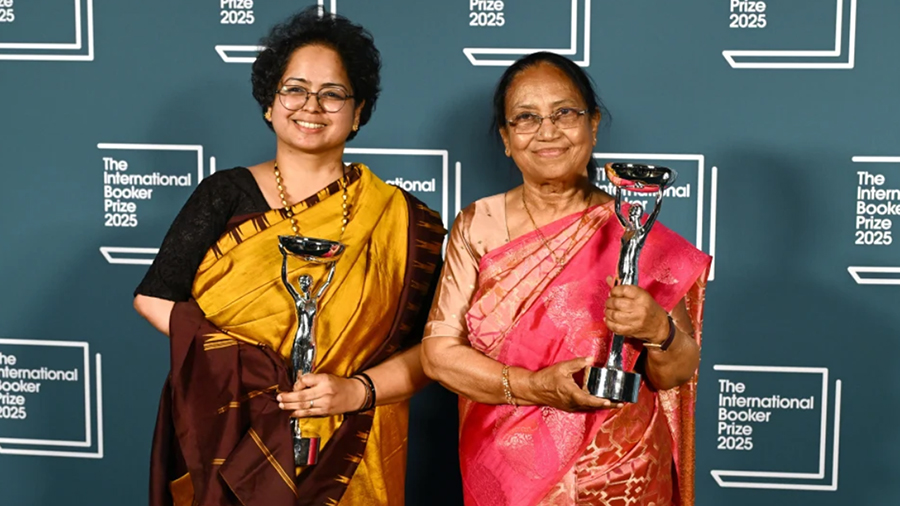
When Banu Mushtaq became the first Kannada author to win the prestigious International Booker Prize for her short story collection Heart Lamp, she didn’t just make literary history—she reignited a conversation about the role of literature in shaping society, and the way schools can nurture future writers not just as hobbyists, but as cultural forces.
Mushtaq, along with translator Deepa Bhasthi, was honoured for Heart Lamp, a collection of stories chronicling the lives of Muslim women in Karnataka across three decades. The stories are rooted in resistance, critique of religious and patriarchal structures, and everyday courage. The recognition was not just for the literary craft, but for the emotional and moral clarity the stories offer—a kind of truth that is rarely rewarded in global spaces. But the International Booker did just that.
And yet, how many students in Indian classrooms today know what the Booker Prize even is? While the Grammys, Oscars and even YouTube Play Buttons are common cultural currency among young people, literary awards often pass under the radar. This needs to change.
The International Booker Prize is one of the most prestigious literary honours in the world, recognising the finest works of fiction translated into English. It opens up space for voices that often remain local to reach a global stage. For students in India, this is an opportunity to understand that writing, especially in regional languages, is not a dead-end path. Yes, it may not offer the instant gratification of a viral video or influencer deal—but as Mushtaq’s life proves, it can shape public discourse, win global accolades, and leave behind a legacy that matters.
For educators, this is a teaching moment. Banu Mushtaq’s story is as much about literary merit as it is about resilience. She wrote in Kannada, a language she adopted over her native Urdu. She survived deep personal trauma, including a suicide attempt, and faced social backlash for her activism. She was a councillor, a journalist, and a lifelong advocate for women’s rights. These are the kinds of role models classrooms should be spotlighting—especially for young girls who need to see that stories, quite literally, can change lives.
Heart Lamp may not be appropriate for every age group, but its themes—identity, voice, justice—can be introduced in many ways. Schools should consider book discussions, literary circles, or even creative writing prompts inspired by such works to encourage students to find their voice, in whatever language or form it may come.
This win is also a reminder that educators need to broaden the definition of success they present to students. STEM, coding, and commerce continue to dominate career conversations, but it’s equally crucial to show that the arts—especially literature—have their own path to impact and influence. We hope for a time when young writers are not asked “what else do you do?” but are valued for what their words bring to the world.
Banu Mushtaq’s Booker Prize win is not just an individual triumph—it’s a collective opportunity. For schools, for students, and for all of us who believe that a powerful story can change minds, communities, and someday, the world.
Education
John King’s Book ‘Teacher By Teacher’: A Global Tribute to the Transformative Power of Education
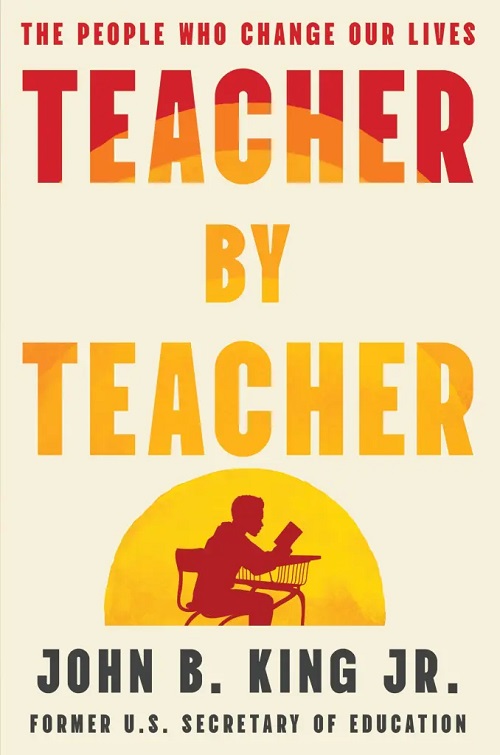
For John B. King Jr., former U.S. Secretary of Education, school wasn’t just a place—it was a lifeline. In his newly released memoir, Teacher By Teacher: The People Who Change Our Lives, King traces his journey from a grief-stricken child in New York to the corridors of educational leadership in Washington, D.C. But while the book is rooted in the American educational experience, its messages about the impact of teachers resonate far beyond U.S. borders.
In an exclusive interview with Education Week’s Sam Mallon on May 5, 2025, King reflected on his memoir, the teachers who shaped his life, and the ongoing challenges educators face worldwide.
A Childhood Saved by Teachers
King’s story is a testament to the power of mentorship. Following the death of his mother and his father’s battle with Alzheimer’s, school became King’s sanctuary. “Teachers saved my life,” he shared, recalling how educators believed in him, nurtured his potential, and gave him hope even when the world outside seemed dark.
From those formative years, King went on to earn degrees from Harvard, Columbia, and Yale. His career as a teacher, school principal, education policymaker, and eventually, U.S. Secretary of Education became a journey of giving back. The memoir celebrates not only King’s personal resilience but the quiet heroism of teachers everywhere.
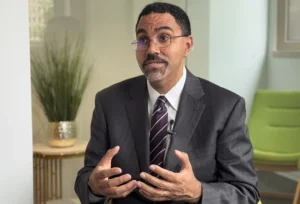
Former Secretary of U.S Education John King. Image Source- EducationWeek
While King’s book is anchored in American education, the messages it carries are universally relevant. Teachers worldwide are grappling with challenges—overcrowded classrooms, mental health issues among students, and ever-changing education policies. In his interview with Education Week, King highlighted how schools must be more than academic factories. They must be safe havens, places of healing, and hubs of inspiration.
King advocates for “trauma-informed practice”—an approach where teachers are equipped to understand and support students facing emotional challenges. This is a lesson that transcends borders, as schools globally encounter rising mental health concerns among students.
Teacher Evaluations and Policy Pressures
King’s time as U.S. Secretary of Education was marked by ambitious reforms—from implementing the Every Student Succeeds Act (ESSA) to pushing for more rigorous teacher evaluation systems. But looking back, he acknowledges a key lesson: change cannot be forced without teacher buy-in.
“Teachers can’t be bombarded with reforms,” he explained. Change must be gradual, and educators must feel a sense of ownership over new policies.
King’s narrative is ultimately about hope. In his memoir, he shares how a single teacher’s encouragement can change a student’s life trajectory. He recalls how his father’s legacy as New York’s first Black deputy schools chief was kept alive by a former student who, years later, shared how impactful his father’s teaching was.
Teaching is more than a job—it is a calling. It is a force for social good, a platform for mentorship, and a means to nurture the next generation of thinkers, leaders, and dreamers. King’s Teacher By Teacher is a reminder that educators everywhere have the power to transform lives, often without even knowing it.
Though written from an American perspective, Teacher By Teacher is a love letter to educators everywhere. It is a call to support teachers, to understand the pressures they face, and to recognise the life-changing impact they can have on their students.
For a world that often takes teachers for granted, John King’s memoir is a reminder of the heroes who stand at the front of every classroom, ready to make a difference.
Excerpts referenced in this article were taken from John King's exclusive interview with Education Week on May 5, 2025, in Washington, conducted by Sam Mallon for Education Week.
Education
Rewriting Ambedkar: Why Students Must Know the Man Beyond the Constitution
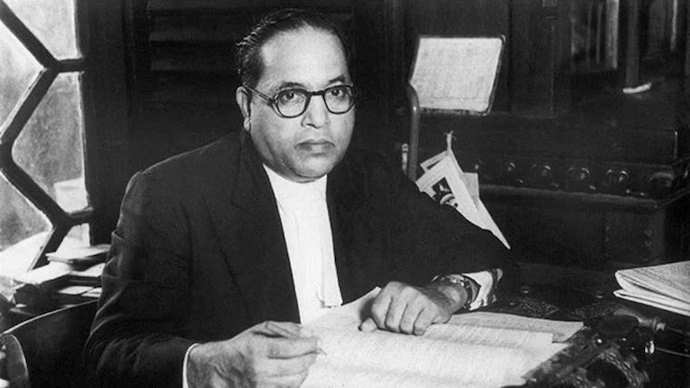
Ambedkar Jayanti Special | ScooNews
Dr. Bhimrao Ramji Ambedkar. Most students in India recognise the name—largely as the “Father of the Indian Constitution.” If you ask a Class 10 student what Ambedkar stood for, you’ll likely get a respectable summary: chairperson of the Drafting Committee, architect of constitutional equality, and perhaps a passing reference to his fight against untouchability. But that’s where it ends.
This is not a failure of our students. This is a failure of our books.
Because Babasaheb Ambedkar was not just a jurist or a political figure to be summarised in three bullet points under Civics. He was one of the most radical, intellectually fierce, and unapologetically liberal minds India has ever known. And if we are talking about modern India—its democracy, its dissent, its diversity, its demands for dignity—then Dr. Ambedkar isn’t just relevant, he is foundational.
And yet, he remains tragically under-read and under-taught.
The Man We Didn’t Read Enough About
Ambedkar’s life is a masterclass in resilience, intellect, and reform. Born into the most marginalised community in India, he went on to become the first Indian to pursue a doctorate in economics from Columbia University, studied law at the London School of Economics, and returned to a country that still wouldn’t allow him to sit beside upper-caste students.
But Ambedkar did not stop at personal success. He turned his education into ammunition. His writings dissected caste not just as a social issue but as an economic and psychological reality. In works like Annihilation of Caste, he boldly challenged not just the religious orthodoxy but also Mahatma Gandhi—a sacred figure for many—in ways that were considered almost blasphemous at the time. And even today.
Unlike Gandhi, who sought reform within the caste system, Ambedkar demanded its demolition. Where Gandhi appealed to morality, Ambedkar appealed to reason, law, and modernity.
This discomfort with Ambedkar’s sharp, unflinching views is perhaps why our textbooks package him safely—as the dignified lawyer with a pen, not the roaring revolutionary with a voice.
More Than a Constitution-Maker
To say Ambedkar gave us the Constitution is both true and painfully incomplete.
- He gave us the right to constitutional morality, the idea that the Constitution isn’t just a set of rules but a living document that must be interpreted in the spirit of liberty, equality, and justice.
- He envisioned reservations not as charity but as corrective justice.
- He believed that a true democracy must have “social democracy” at its base—not just the right to vote but the right to dignity in everyday life.
- And he warned, prophetically, that political democracy without social democracy would be India’s downfall. He was not just designing India’s governance system, but was rather trying to develop India’s moral spine.
A Voice for Individual Freedom—Louder Than We Knew
“I measure the progress of a community by the degree of progress which women have achieved.”- Bhim Rao Ambedkar
Ambedkar’s liberalism was far ahead of his time. He consistently advocated for individual rights in the truest sense. There’s documented evidence that he argued for the decriminalisation of same-sex relationships, seeing it as an issue of individual freedom long before such conversations entered our legal discourse.
His economic ideas—rarely taught—favoured state-led industrialisation, fair wages, and social security decades before these became policy buzzwords. His writings on women’s rights were equally progressive, particularly through the Hindu Code Bill, which sought to grant women equal property rights, rights to divorce, and freedom in marriage—a bill so radical for its time that it was shelved, only to return years later in diluted forms.
Why Today’s Students Need Ambedkar—Unfiltered
In an age where freedom of speech is contested, when marginalised voices still struggle for space, when gender and sexuality are still debated as ‘issues’ instead of identities—Ambedkar is the teacher we didn’t know we needed.
We need to stop sanitising him for our syllabus. We need high schoolers to read Annihilation of Caste in their literature classes and understand the intersections of caste, religion, and gender in history—not just from an upper-caste nationalist lens but from the view of the people who fought to be seen as human.
We need Ambedkar in economics classrooms, debating his views against today’s neoliberal models.
We need to introduce him as an intellectual, a radical thinker, a critic of Gandhi, a reformer of Hindu personal law, a journalist, a linguist, a labour rights advocate, a rebel with a cause.
Because the freedoms we enjoy today—freedom of religion, freedom of expression, freedom to love, to choose, to protest, to dream—all have Ambedkar’s fingerprints on them.
If our education system truly believes in nurturing critical thinkers and empathetic citizens, then Dr. Ambedkar cannot remain a footnote or a ceremonial portrait garlanded on April 14th.
He must be read. He must be debated. He must be understood. Because the more we know about Ambedkar, the more we know about ourselves—and the democracy we’re still trying to build.
Education
“Be the Change in a Changing World”: Anita Karwal and Anju Chazot Reflect on NEP 2020
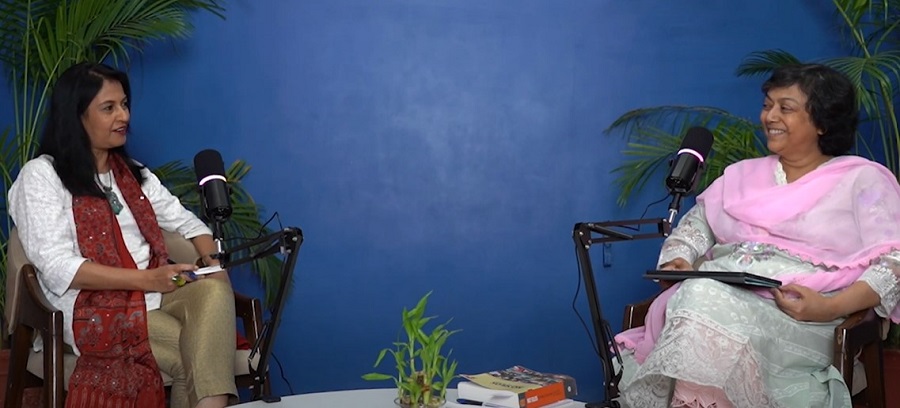
In a deeply reflective and engaging episode of the NEP Tunes podcast, Dr. Anju Chazot, education reformer and founder of Mahatma Gandhi International School (MGIS), Ahmedabad, sat down with Mrs. Anita Karwal, former Secretary of School Education, Government of India, to explore one fundamental question: How do we prepare children for a rapidly changing world?
Titled “Be the Change in the Changing World,” the episode offers a powerful conversation between two veterans of Indian education who have shared a decades-long friendship—and a mutual vision for a holistic and transformative school system.
“You can’t prepare children for tomorrow with the pedagogy of the day before yesterday.”
Drawing inspiration from John Dewey’s famous words, the episode begins by addressing the urgent need for policy literacy among stakeholders in education. Mrs. Karwal and Dr. Chazot underscore that the pace of global change—technological, environmental, economic, and emotional—has far outstripped the ability of traditional education systems to keep up. “We are in a VUCA world—volatile, uncertain, complex, ambiguous,” Karwal reminds listeners, calling for schools to adapt to this reality rather than resist it.
Decolonising the Classroom
A significant portion of the conversation focused on the historical context of schooling in India. Dr. Chazot draws parallels between today’s school system and Michel Foucault’s “cell and bell” model, which mirrors the prison system—marked by uniforms, bells, and rigid structures. Tracing the roots of modern schooling to the Prussian military model and colonial-era policies introduced by Lord Macaulay, both speakers lamented how education was once used as a tool to produce clerks for the Empire, rather than creative, entrepreneurial individuals.
“Colonialism didn’t just take away our resources; it colonised our minds,” Chazot observed. Karwal added, “The gurukul system was rooted, contextual, and sustainable. The colonial model replaced it with standardisation and control.”
Disruptions and the Call for Change
From climate change to AI, from the gig economy to rising mental health challenges—today’s youth are living in an era of non-stop disruptions. Mrs. Karwal shared a poignant insight: on the very day she retired from her government service (30 November 2022), OpenAI launched ChatGPT. “As a senior citizen, I would have felt useless had I not tried to understand this disruption,” she said, urging listeners to stay updated with technological trends.
Mental health also featured prominently in the discussion. The World Health Organization reports a 25% increase in global anxiety and depression cases, especially among the youth. Schools, Karwal said, must acknowledge and address this invisible epidemic, and create environments that are nurturing—not anxiety-inducing.
Why NEP 2020 Is a Game Changer
Against this backdrop, both educators believe the National Education Policy 2020 is a timely and visionary document. “It’s not just about academics—it’s about the whole child,” said Chazot, pointing to NEP’s focus on holistic development across cognitive, emotional, physical, and ethical domains.
Key elements of the NEP and the newly released National Curriculum Framework (NCF) discussed in the podcast include:
-
A shift from rote learning to competency-based, experiential learning
-
Focus on Indian traditions and cultural rootedness
-
Moving away from exam-centric teaching, especially in early years
-
Recognition of multilingualism and contextual learning
-
Encouragement of critical thinking, creativity, and adaptability
“Learning to learn is the most essential skill of the future,” Karwal stressed. “Children must be ready to unlearn and relearn throughout life.”
The Future of Jobs
To illustrate the rapidly changing employment landscape, both speakers listed a host of emerging careers—from Prompt Engineers and Drone Fleet Managers to Climate Data Analysts and Digital Detox Specialists. “Just imagine,” Chazot quipped, “if I were a child again, I’d become a Prompt Engineer and finally fulfil my parents’ dreams of being an engineer—with a creative twist!”
Karwal, on the other hand, expressed a desire to become a Human-Machine Team Manager—a futuristic role bridging collaboration between people and machines.
Their message was clear: the world our children are entering is drastically different from the one their parents and teachers grew up in. And education must keep up.
A Takeaway Challenge for Listeners
To wrap up the episode, the hosts offered a unique call-to-action: ask yourself what job you would pick today if you could go back in time again. Then, explore new professions with your family or students. From LinkedIn job listings to the World Economic Forum’s reports, Karwal recommended several tools to research emerging careers. They invited listeners to write in with their findings and reflections.
“This exercise is not just for students,” said Dr. Chazot. “It’s for parents, teachers, and policy-makers alike. We must all become learners again.”
Final Thoughts
In an era where the only constant is change, the NEP Tunes podcast is a timely resource to help educators, parents, and students reimagine the purpose of schooling. With leaders like Anju Chazot and Anita Karwal at the helm of the conversation, the journey towards meaningful transformation in Indian education seems not only possible—but exciting.
🟡 This article is adapted from the NEP Tunes podcast hosted by Dr. Anju Chazot. You can listen to the full episode on YouTube. Here is the video-
Education
Sunbeam Indiranagar Shines in Academics, Arts, and Sports, Cementing Its Legacy of Holistic Education
-

 Education2 months ago
Education2 months agoCBSE’s ‘Sugar Boards’ Initiative: Tackling the Sweet Crisis in Indian Schools
-

 Education3 months ago
Education3 months agoIs Your School Following These Mandatory CBSE Committees?
-
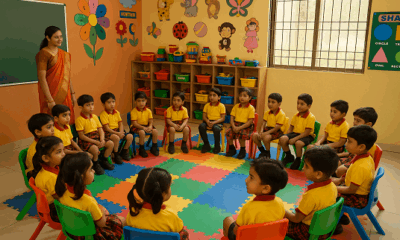
 Education3 months ago
Education3 months agoMaharashtra to Regulate Pre-Primary Education with New Law Aligned to NEP 2020
-

 Education3 months ago
Education3 months agoMAHAJYOTI’s Book Distribution Scheme to Empower 7,000 OBC Students Preparing for JEE/NEET & MHT-CET
-
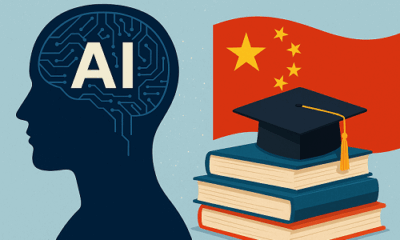
 Education3 months ago
Education3 months agoChina Embarks on Ambitious AI-Driven Education Reform to Build a ‘Strong Education Nation’ by 2035
-
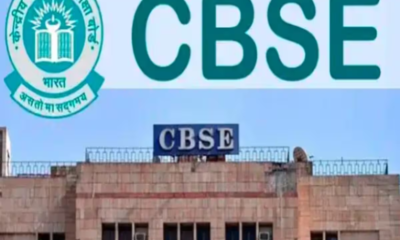
 Education3 months ago
Education3 months agoCBSE Introduces Mandatory Bridge Course for Classes 6 to 12 in Chhattisgarh Under NEP 2020
-
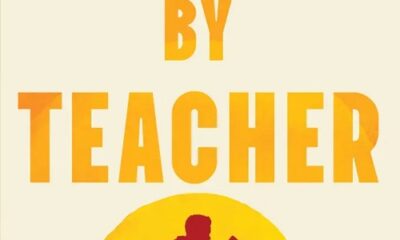
 Education2 months ago
Education2 months agoJohn King’s Book ‘Teacher By Teacher’: A Global Tribute to the Transformative Power of Education
-
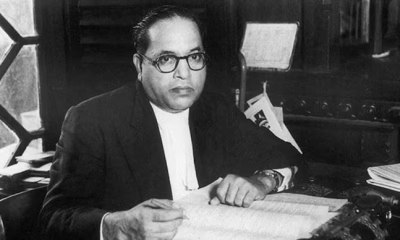
 Education3 months ago
Education3 months agoRewriting Ambedkar: Why Students Must Know the Man Beyond the Constitution
-
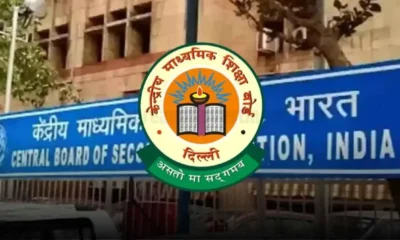
 Education3 months ago
Education3 months agoCBSE Mandates 50-Hour Annual Training for Teachers, Declares STEM as 2025 Theme
-
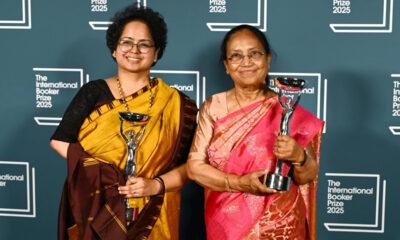
 Education2 months ago
Education2 months agoBanu Mushtaq’s International Booker Win Is a Wake-Up Call for Indian Schools to Reclaim Literature




